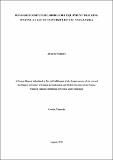| dc.description.abstract | In today’s digital age, computer laboratories’ adoption in academic institutions and the security
of equipment are crucial to ensure their effective functioning and prevent equipment loss or
damage. These laboratories have valuable equipment, such as laptops, switches, routers,
projectors, printers, and scanners, that require proper security measures to prevent losses or
damages. Manual methods such as pen and paper, spreadsheets and tracking software have
been commonly used in the past for equipment tracking. However, these approaches have
certain limitations, such as being time-consuming, having limited storage and retrieval abilities,
and not providing real-time updates. To overcome these challenges and enhance the lab
equipment tracking system, the objective of the developed system is to identify the necessary
requirements for designing, developing and validating an IoT-based computer lab equipment
tracking system to manage high-value lab equipment at Université du Lac Tanganyika (ULT)
university and prevent the unauthorised removal of equipment from the laboratory. The study
employs Radio Frequency Identification (RFID) technology to track and identify automatically
tags attached to the equipment. This study used Agile’s Scrum framework as a system
development approach, and a qualitative research approach, including interviews,
observations, and focus group discussions, was used to collect data for the functional and non functional requirements. An ESP32 microcontroller was used to collect and process data from
sensors and send the data to the IoT cloud. An Advanced Encryption Standard (AES)
encryption and decryption algorithm using a 128-bit key was implemented to ensure the secure
transmission of RFID data. The system also features an automatic lock-unlock mechanism to
prevent equipment from moving out of the lab without authorisation. A web application with
a simple interface was developed for the equipment management system. Ultimately, the
system validation process engaged 51 participants comprising IT managers, lab assistants, lab
technicians, and lab users. All participants filled out a system evaluation form which resulted
in positive responses. The results of the system validation analysis indicate an average of 87%
of performance, availability, accuracy, efficiency, and effectiveness. Therefore, ULT
University accepted the system due to its effectiveness, security features, and user-friendly
interface. | en_US |

